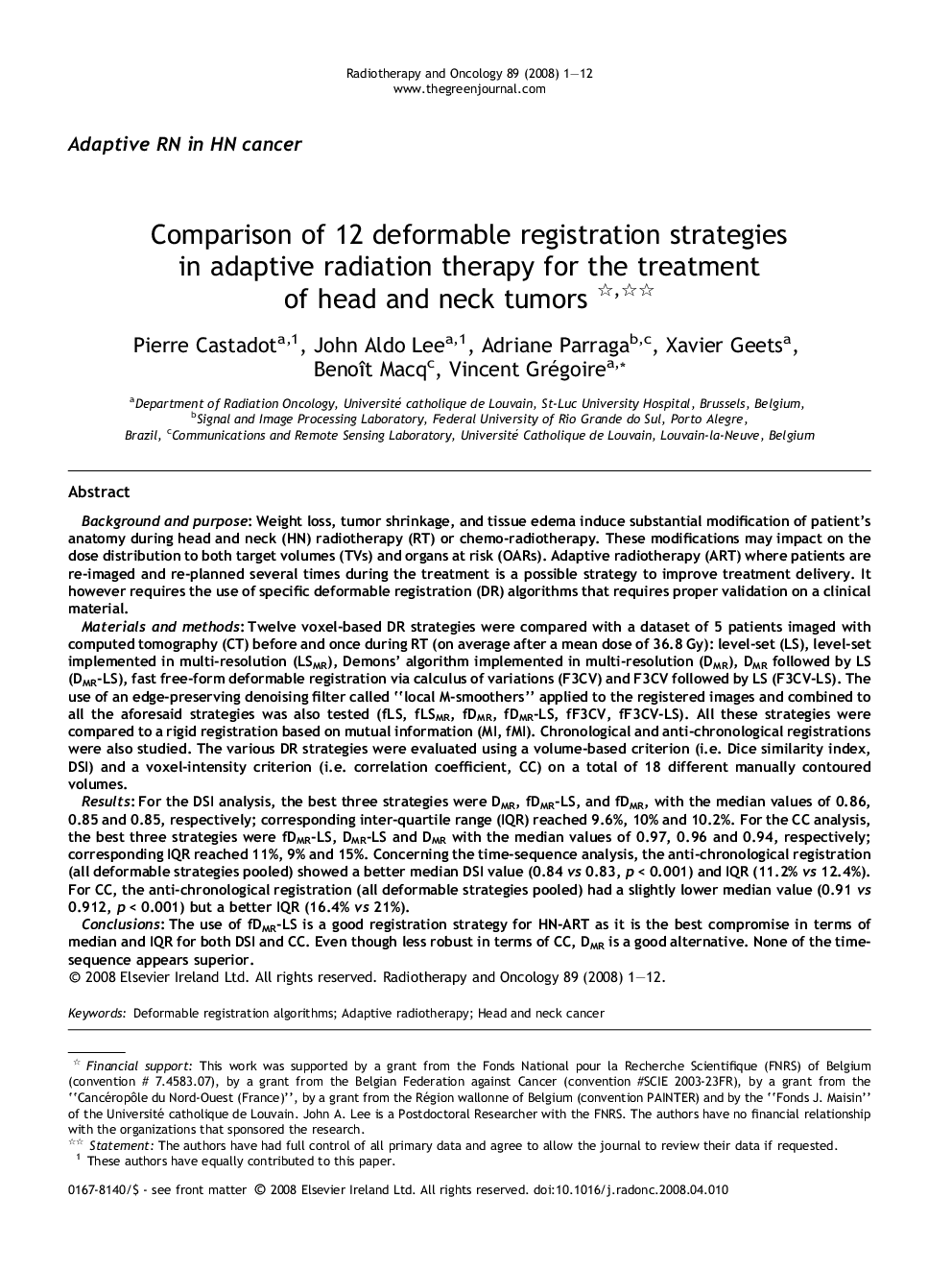| کد مقاله | کد نشریه | سال انتشار | مقاله انگلیسی | نسخه تمام متن |
|---|---|---|---|---|
| 2160293 | 1090879 | 2008 | 12 صفحه PDF | دانلود رایگان |

Background and purposeWeight loss, tumor shrinkage, and tissue edema induce substantial modification of patient’s anatomy during head and neck (HN) radiotherapy (RT) or chemo-radiotherapy. These modifications may impact on the dose distribution to both target volumes (TVs) and organs at risk (OARs). Adaptive radiotherapy (ART) where patients are re-imaged and re-planned several times during the treatment is a possible strategy to improve treatment delivery. It however requires the use of specific deformable registration (DR) algorithms that requires proper validation on a clinical material.Materials and methodsTwelve voxel-based DR strategies were compared with a dataset of 5 patients imaged with computed tomography (CT) before and once during RT (on average after a mean dose of 36.8 Gy): level-set (LS), level-set implemented in multi-resolution (LSMR), Demons’ algorithm implemented in multi-resolution (DMR), DMR followed by LS (DMR-LS), fast free-form deformable registration via calculus of variations (F3CV) and F3CV followed by LS (F3CV-LS). The use of an edge-preserving denoising filter called “local M-smoothers” applied to the registered images and combined to all the aforesaid strategies was also tested (fLS, fLSMR, fDMR, fDMR-LS, fF3CV, fF3CV-LS). All these strategies were compared to a rigid registration based on mutual information (MI, fMI). Chronological and anti-chronological registrations were also studied. The various DR strategies were evaluated using a volume-based criterion (i.e. Dice similarity index, DSI) and a voxel-intensity criterion (i.e. correlation coefficient, CC) on a total of 18 different manually contoured volumes.ResultsFor the DSI analysis, the best three strategies were DMR, fDMR-LS, and fDMR, with the median values of 0.86, 0.85 and 0.85, respectively; corresponding inter-quartile range (IQR) reached 9.6%, 10% and 10.2%. For the CC analysis, the best three strategies were fDMR-LS, DMR-LS and DMR with the median values of 0.97, 0.96 and 0.94, respectively; corresponding IQR reached 11%, 9% and 15%. Concerning the time-sequence analysis, the anti-chronological registration (all deformable strategies pooled) showed a better median DSI value (0.84 vs 0.83, p < 0.001) and IQR (11.2% vs 12.4%). For CC, the anti-chronological registration (all deformable strategies pooled) had a slightly lower median value (0.91 vs 0.912, p < 0.001) but a better IQR (16.4% vs 21%).ConclusionsThe use of fDMR-LS is a good registration strategy for HN-ART as it is the best compromise in terms of median and IQR for both DSI and CC. Even though less robust in terms of CC, DMR is a good alternative. None of the time-sequence appears superior.
Journal: Radiotherapy and Oncology - Volume 89, Issue 1, October 2008, Pages 1–12